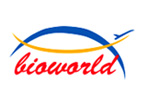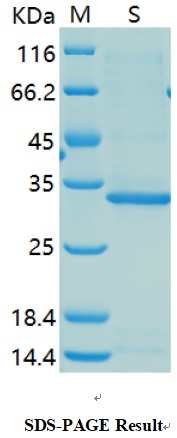Product Name :
CD136/RON Recombinant Protein Swiss-Prot :
Q04912 Host :
E.coli Tag :
≥0.5mg/ml Amino acid Sequence :
ASFSDSEDESCVPLLRKESIQLRDLDSALLAEVKDVLIPHERVVTHSDRVIGKGHFGVVYHGEYIDQAQNRIQCAIKSLSRITEMQQVEAFLREGLLMRGLNHPNVLALIGIMLPPEGLPHVLLPYMCHGDLLQFIRSPQRNPTVKDLISFGLQVARGMEYLAEQKFVHRDLAARNCMLDESFTVKVADFGLARDILDREYYSVQQHRHARLPVKWMALESLQTYRFTTKSDVWSFGVLLWELLTRGAPPYRHIDPFDLTHFLAQGRRLPQPEYCPDSLYQVMQQCWEADPAVRP Restriction sites :
NdeI-XhoI Background :
Ron is a member of the Met protooncogene family of receptor tyrosine kinases, which also includes Stk, c-Met, and c-Sea. The functional Ron is a heterodimer composed of a 40 kDa α chain and a 150 kDa β chain. Ron is initially synthesized in the cells as a single-chain, pro-Ron precursor that is cleaved into the two active chains. The α chain is completely extracellular, whereas the β chain traverses the cell membrane and contains the intracellular tyrosine kinase and regulatory elements. Ron mediates multiple signaling cascades that involve cell motility, adhesion, proliferation, and apoptosis. The signaling pathways activated downstream of Ron include the ras/mitogen-activated protein kinase (MAPK), phosphatidyl inositol-3 kinase (PI3K)/Akt, and focal adhesion kinase (FAK) pathways. Ron activation can also significantly increase c-Src activity, a signaling intermediate involved in cell cycle progression, motility, angiogenesis and survival. The function of Ron has been shown to be important for embryological development as well as implicated in the progression and metastasis of tumors. Soluble :
PBS, 4M Urea, PH7.4 Purification&Purity :
Transferred into competent cells and the supernatant was purified by NI column affinity chromatography and the purity is > 85% (by SDS-PAGE). Storage&Stability :
Store at 4°C short term. Aliquot and store at -20°C long term. Avoid freeze-thaw cycles. Expression vector :
pet-22b(+) BiowMW :
~32kDa Note :
For research use only, not for use in diagnostic procedure. concentration :
≥0.5mg/ml
CD136/RON Recombinant Protein Swiss-Prot :
Q04912 Host :
E.coli Tag :
≥0.5mg/ml Amino acid Sequence :
ASFSDSEDESCVPLLRKESIQLRDLDSALLAEVKDVLIPHERVVTHSDRVIGKGHFGVVYHGEYIDQAQNRIQCAIKSLSRITEMQQVEAFLREGLLMRGLNHPNVLALIGIMLPPEGLPHVLLPYMCHGDLLQFIRSPQRNPTVKDLISFGLQVARGMEYLAEQKFVHRDLAARNCMLDESFTVKVADFGLARDILDREYYSVQQHRHARLPVKWMALESLQTYRFTTKSDVWSFGVLLWELLTRGAPPYRHIDPFDLTHFLAQGRRLPQPEYCPDSLYQVMQQCWEADPAVRP Restriction sites :
NdeI-XhoI Background :
Ron is a member of the Met protooncogene family of receptor tyrosine kinases, which also includes Stk, c-Met, and c-Sea. The functional Ron is a heterodimer composed of a 40 kDa α chain and a 150 kDa β chain. Ron is initially synthesized in the cells as a single-chain, pro-Ron precursor that is cleaved into the two active chains. The α chain is completely extracellular, whereas the β chain traverses the cell membrane and contains the intracellular tyrosine kinase and regulatory elements. Ron mediates multiple signaling cascades that involve cell motility, adhesion, proliferation, and apoptosis. The signaling pathways activated downstream of Ron include the ras/mitogen-activated protein kinase (MAPK), phosphatidyl inositol-3 kinase (PI3K)/Akt, and focal adhesion kinase (FAK) pathways. Ron activation can also significantly increase c-Src activity, a signaling intermediate involved in cell cycle progression, motility, angiogenesis and survival. The function of Ron has been shown to be important for embryological development as well as implicated in the progression and metastasis of tumors. Soluble :
PBS, 4M Urea, PH7.4 Purification&Purity :
Transferred into competent cells and the supernatant was purified by NI column affinity chromatography and the purity is > 85% (by SDS-PAGE). Storage&Stability :
Store at 4°C short term. Aliquot and store at -20°C long term. Avoid freeze-thaw cycles. Expression vector :
pet-22b(+) BiowMW :
~32kDa Note :
For research use only, not for use in diagnostic procedure. concentration :
≥0.5mg/ml
Blocking peptide available as NCP0175P

 CD136/RON Recombinant Protein
CD136/RON Recombinant Protein 
 Datasheet
Datasheet COA
COA MSDS
MSDS SHIP
SHIP